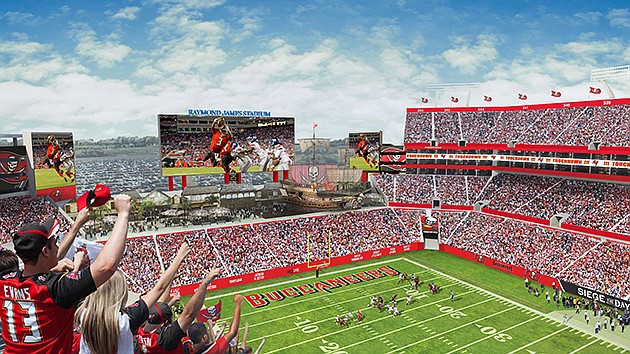SweetSpot
Raymond James Stadium
Why 2016 is important: Work will begin on a $100 million renovation, which could help the city win another Super Bowl bid.
Raymond James Stadium in Tampa is already slated to host the college football National Championship in 2017, but city officials and area sports leaders have bigger goals in mind.
Following approval of a two-phase renovation project expected to exceed $100 million, the home stadium of the Tampa Bay Buccaneers is positioning itself for a run at hosting a Super Bowl in the next five years. The city is already a finalist to host the Super Bowl in 2019 or 2020, according to Rob Higgins, executive director of the Tampa Sports Commission. It's competing with Miami, Atlanta and New Orleans, he says.
Raymond James Stadium hosted Super Bowl XXXV in 2001 and XLIII in 2009, so sports officials in the area are somewhat familiar with the process to land the NFL's annual championship game. Although there are multiple deciding factors, Higgins hopes the new Raymond James project, approved by Tampa city and Hillsborough County officials in mid-December, will be an advantage in the “ultra-competitive process.”
“In general, it starts with the facility,” Higgins says on the Super Bowl's decision process. Higgins says other elements, such as nearby hotels and special event venues, are important, but the most crucial aspect is “a venue that creates an incredible fan experience.”
The improvements to create that fan experience at Raymond James, with work scheduled to begin this month, include a new sound system, improved luxury suites and concession stands, and video display and scoreboard enhancements. After the upgrades, Raymond James will have the NFL's third-largest video display area, according to a statement from the Buccaneers.
The benefits of the stadium improvements also extend beyond football, to possibly targeting soccer matches.
“I think these improvements were essential for our ability to host and attract major events,” Higgins says. “Before this, we were falling behind the curve from a national standpoint.”
The renovations to the stadium are split into two phases and will be funded by the Buccaneers and the Tampa Sports Authority, according to the statement from the team. The Bucs are committed to at least $29 million in the first phase and at least $28.8 million in the second, the statement says. The Tampa Sports Authority will contribute $28.8 million to the project — $3 million more than required in the 1996 contract it signed when the stadium was built.
Phase one of the project is scheduled to begin in January 2016 and conclude prior to the 2016 NFL season. It will include renovations to the video displays, sound system and luxury suites, the statement says.
The second phase, scheduled to begin after the 2017 National Championship, will include changes to the concourse, club lounges and team store, according to the statement. It's scheduled to be completed before the 2017 NFL season.
Follow Steven Benna on Twitter @steve_benna






